Chapter 7 - CH7 PDF

| Title | Chapter 7 - CH7 |
|---|---|
| Author | Jane Kwok |
| Course | Introduction to Financial Accounting |
| Institution | York University |
| Pages | 18 |
| File Size | 355.2 KB |
| File Type | |
| Total Downloads | 543 |
| Total Views | 807 |
Summary
1 the past five years, a company had average annual credit sales of $320,000 and an average annual net write-offs of $2,000. Credit sales in the current year are $300,000. Using the percentage of credit sales method, what should the company record as an estimate of bad debt expense?$1,$2,$20,$6,None...
Description
1.Over the past five years, a company had average annual credit sales of $320,000 and an average annual net write-offs of $2,000. Credit sales in the current year are $300,000. Using the percentage of credit sales method, what should the company record as an estimate of bad debt expense? $1,875 $2,000 $20,000 $6,000 None of the above 2. At December 31, 2012, Chambers Co. has gross accounts receivable of $127,000. There is a $10,000 credit balance in the allowance for doubtful accounts at the beginning of the year. During the year, the company had sales of $480,000, 30% of which were credit sales. The company uses the percentage of sales basis to estimate bad debt expense. Historically, bad debt expense has averaged 1.5% of credit sales. Actual write-offs of accounts receivable for 2012 amount to $ 3,240.
The company's bad debt expense for 2012 is: $1,905 $7,200 $10,000 None of the other alternatives are correct $2,160 3. On average, 5% of total accounts receivable has been uncollectible in the past. At the end of the year, balance of accounts receivable is $100,000 and the allowance for doubtful accounts has a credit balance of $500. Credit sales during the year were $150,000. Using the aging of accounts receivable method, the estimated bad debt expense would be: $6,000 $5,000 $4,500 indeterminable; the aging of accounts receivable method cannot be used, because, based on this information, the percentage of credit sales method should be used. $5,500 4. The following is an Aged Accounts Receivable Listing for Company A at March 31, 2015 Customer Current 0-30 days 30-60 days 60+ % Uncollectible 0% 2% 3% 4% Adele 100,000 40,000 8,000 0 Bart 220,000 10,000 10,000 10,000 Carol 94,000 0 0 7,000 Dustin 80,000 75,000 12,000 4,000
The balance in the Allowance for Doubtful Accounts before any adjustment is $8,630 (the account is in its normal balance). What is the adjustment required to the Allowance for Doubtful Accounts to record provision for credit losses at March 31, 2015? $4,610 debit $4,390 debit
$4,610 credit None of the other alternatives are correct $4,390 credit 5. Abdul's Inc. converts an unpaid account receivable into a 60 day, 12% note for $3,000. Which of the following is the correct journal entry to be recorded upon maturity of the note receivable? Dr. Cash $3,060. Cr. Note Receivable $3,000. Cr. Interest Revenue $60 None of the other alternatives are correct Dr. Cash $3,360. Cr. Account Receivable $3,000. Cr. Sales $360 Dr. Cash $3,360. Cr. Note Receivable $3,000. Cr. Interest Revenue $360 Dr. Note Receivable $3,000. Dr. Interest Revenue $60. Cr. Cash $3,060 6. Which of the following is a valid alternative action for an organization to take to minimize credit losses? Force collections with expensive penalties for late payments. Implement a system of formal naming and shaming for customers making late payments. None of the other alternatives are correct Never sell on credit. Review accounts receivables on a regular basis. 7. Assume Adam borrows $1,000 from Eve and gives her a Note which matures in 6 months and the borrowing rate is 8% per annum. If the note is paid on maturity then Eve will record $40 in interest expense None of the above statements are correct If the note is paid on maturity then Eve will record $80 in interest income If Adam prepares financial statements prior to the maturity date of the note, he will have to make an adjusting entry to set up the interest income earned If the note is dishonoured on maturity then Eve will set up a receivable for more than $1,000 8. Richmond Hill Company had accounts receivable of $770,000 and an allowance for doubtful accounts of the $23,500 just prior to writing off as worthless an account receivable for Vaughan Company of $8,000. The net realizable value of accounts receivable as shown by the accounting record before and after the write-off was as follows: Before $738,500, After $762,000 Before $ 770,000, After $ 762,000 Before $746,500, After $746,500 Before $746,500, After $738,500 Before $770,000, After $770,000 9. The direct write-off method results in higher bad debt expense for most companies may only be used by companies that do not extend credit to their customers. ignores the matching principle none of the above is an acceptable alternative method of recognizing bad debt expense under GAAP. 10. General Toys Incorporated has an Accounts Receivable balance at year end of $160,000. The Allowance for Doubtful Accounts has a credit balance of $1,200 at year end. Upon review of the Accounts Receivable subsidiary you notice that there is $161,500 of debit balances and $1,500 of credit balances. At year end management prepared the following analysis:
Aging Buckets Accounts Receivable Percentage doubtful Current $134,000 1% 0 - 60 days $15,000 5% 61- 180 days $8,000 15% Over 6 months $4,500 35% Total $161,500
How much should be recorded for the provision for credit losses at year end for General Toys Incorporated based on management's analysis? None of the other alternatives are correct $6,065 Cr. to allowance for doubtful accounts $4,865 Cr. to allowance for doubtful accounts $3,665 Dr. to allowance for doubtful accounts $3,665 Cr. to allowance for doubtful accounts 11. The Blue Bends Co. signed a 12%, $40,000 note payable on September 1, 20X1 due on February 28, 2099. If the accounting year ends on December 31, how much is the interest expense for 2099, the year the note was repaid? $2,400 $1,600 $800 $4,800 None of the other alternatives are correct 12. Company ABC Inc. has a balance of accounts receivable of $111,000. The balance of Allowance for Doubtful Accounts is $900 in a normal credit position. Two thirds of the accounts receivable are current and one third are overdue. ABC Inc. estimates that 1% of of the current accounts receivable and 6% of the overdue accounts receivable will be uncollectible. The adjusting entry for uncollectible accounts receivables should be in the amount of: $2,220 None of the other alternatives are correct $2,060 $2,960 $2,160 13. Chocolate Corner Company had the following transactions during the current year: Apr. 8. Received a $7,050, 75-day, 8% note from Lance Armstrong in payment of account. May 24.Wrote off customer Joe Nutella's account against the Allowance for Uncollectible Accounts, $150 June 22. Received payment of Lance Armstrong's note in full. Sept. 10.Gave a $5,600, 90-day, 9% note to Herbert Anson in payment of account. Sept.18. Received payment of Joe Nutella's account, written off May 24. Dec 9. Paid principal and interest due on note to Herbert Anson. Please Note: a 360-day year is standard for many such interest computations - for this course interest is to the nearest month rather than precisely to the day. Round interest to the nearest dollar (no cents). If needed record the above transactions in general journal form.
The journal entry on May 24th has the following: Cr. Notes Receivables - Joe Nutella $150 Dr Accounts Receivables - Joe Nutella $150 Dr. Allowance for Uncollectible Accounts $150 None of the other alternatives are correct Cr. Allowance for Uncollectible Accounts $150
14. Chocolate Corner Company had the following transactions during the current year: Apr. 8. Received a $7,050, 75-day, 8% note from Lance Armstrong in payment of account. May 24.Wrote off customer Joe Nutella's account against the Allowance for Uncollectible Accounts, $150 June 22. Received payment of Lance Armstrong's note in full. Sept. 10.Gave a $5,600, 90-day, 9% note to Herbert Anson in payment of account. Sept.18. Received payment of Joe Nutella's account, written off May 24. Dec 9. Paid principal and interest due on note to Herbert Anson. Please Note: a 360-day year is standard for many such interest computations - for this course interest is to the nearest month rather than precisely to the day. Round interest to the nearest dollar (no cents). If needed record the above transactions in general journal form. On Dec 9th cash is paid in the amount of: $5,474 None of the other alternatives are correct $5,754 $5,726 $5,446 15. A contra account: Sits opposite to another related account on the opposite side of the balance sheet Is an offset to its related parent account Is only found in the income statement in the Cost of Goods Sold section Is used in the cash basis of accounting but not in accrual accounting None of the above 16. Richmond Hill Company had accounts receivable of $200,000 and an allowance for doubtful accounts of the $30,000 just prior to writing off as worthless an account receivable for Excelsior Company of $10,000. The net realizable value of accounts receivable as shown by the accounting record before and after the write-off was as follows: Before $170,000, After $160,000 None of the other alternatives are correct Before $170,000, After $170,000 Before $200,000, After $190,000 Before $200,000, After $200,000
17. Ronda's Corporation factored (sold) a two month 12% $3,000 note to a collection agency (Bridge's Inc.) for $3,030 one month after issuance. Which of the following statements is true with regards to this transaction? None of the other alternatives are correct Ronda's Corporation will record a journal entry to Dr. Note receivable $3,000. Dr. Interest Income $30 and Cr. Cash $3,030 The note receivable of $3,000 has now been pledged as security to Bridge's Inc. If the note was factored with recourse, we do not need a note in the financial statements It is currently Ronda's Corporation's obligation to collect the note of $3,000
18. Chocolate Corner Company had the following transactions during the current year: Apr. 8. Received a $7,050, 75-day, 8% note from Lance Armstrong in payment of account. May 24.Wrote off customer Joe Nutella's account against the Allowance for Uncollectible Accounts, $150 June 22. Received payment of Lance Armstrong's note in full. Sept. 10.Gave a $5,600, 90-day, 9% note to Herbert Anson in payment of account. Sept.18. Received payment of Joe Nutella's account, written off May 24. Dec 9. Paid principal and interest due on note to Herbert Anson. Please Note: a 360-day year is standard for many such interest computations - for this course interest is to the nearest month rather than precisely to the day. Round interest to the nearest dollar (no cents). If needed record the above transactions in general journal form. The journal entries on Sep 18th have the following: Dr. Notes Receivables - J. Nut $150 Cr. Allowance for Uncollectible Accounts $150 None of the other alternatives are correct Cr Cash $150 Dr. Allowance for Uncollectible Accounts $150 19. Company ABC sold a 13% three month $4,000 note receivable to Company XYZ for $4,090 two months after issuance with recourse. Which of the following is correctly part of the journal entry required for the sale? No entry is recorded when a note receivable is sold with recourse, only note disclosure is required. Cr. note receivable $4,000, Dr. cash $4,090 and Cr. Interest revenue $90 Cr. accounts receivable $4,000 Cr. note receivable $4,000 and Dr. Cash $4,000 Dr. cash $4,000
20. The following is the Aged Accounts Receivable Listing for XYZ Inc. at January 31, 2016:
Customer Name Current 0 - 30 Days 30 - 60 Days 60+ Days % Uncollectible 1% 2% 4% 5% AAA 21,000 42,000 39,500 4,000 BBB 19,000 19,000 19,500 22,000
CCC DDD
5,000 5,000 12,000 5,000
7,500 5,500
9,000 9,000
The balance in the Allowance for Doubtful Accounts is $2,500 debit. What is the appropriate adjustment XYZ Inc. needs to make at January 31, 2016 to update its provision for credit losses? $9,570 $4,570 $9,490 $7,070 $6,980 21. Choose the term that is associated with estimating the uncollectible accounts balance existing in the accounts receivable ledger: All of the above statements are appropriated used in describing this process Showing receivables at NRV Estimating the required allowance for doubtful accounts Using the aging method Estimating bad debts expense
22. Chocolate Corner Company had the following transactions during the current year:
Apr. 8. Received a $7,050, 75-day, 8% note from Lance Armstrong in payment of account. May 24.Wrote off customer Joe Nutella's account against the Allowance for Uncollectible Accounts, $150 June 22. Received payment of Lance Armstrong's note in full. Sept. 10.Gave a $5,600, 90-day, 9% note to Herbert Anson in payment of account. Sept.18. Received payment of Joe Nutella's account, written off May 24. Dec 9. Paid principal and interest due on note to Herbert Anson. Please Note: a 360-day year is standard for many such interest computations - for this course interest is to the nearest month rather than precisely to the day. Round interest to the nearest dollar (no cents). If needed record the above transactions in general journal form. The balance of Accounts Receivable at April 10th is: None of the other alternatives are correct $7,200 $575 $7,050 $150
23. The correct equation that applies to the determination of the ending balance of the Allowance for Doubtful Accounts is: Beginning Allowance for Doubtful Accounts - Accounts Written-off during the period - Bad Debt Expense for the period None of the other alternatives are correct Beginning Allowance for Doubtful Accounts - Accounts Written-off during the period + Bad Debt Expense for the period Beginning Allowance for Doubtful Accounts + Accounts Written-off during the period + Bad Debt Expense for the period Bad Debt Expense for the period - Beginning Allowance for Doubtful Accounts - Accounts Written-off during the period 24. The following is the Aged Accounts Receivable Listing for XYZ Inc. at January 31, 2016:
Customer Name Current 0 - 30 Days 30 - 60 Days 60+ Days % Uncollectible 1% 2% 4% 5% AAA 20,000 42,000 39,000 4,000 BBB 19,000 19,000 19,000 22,000 CCC 5,000 5,000 7,000 9,000 DDD 12,000 5,000 5,000 9,000
The balance in the Allowance for Doubtful Accounts $2,500 debit. What is the appropriate adjustment XYZ Inc. needs to make at January 31, 2016 to update its provision for credit losses? $9,480 $4,480 Cannot be computed since there is an error in the opening Allowance balance $6,980 Can be calculated, but none of the other alternatives are correct 25. Guinevere Company has the following data extracted from its Accounts Receivable records at June 30, 2011
Customer Balance Current 31 -75 days Over 75 days A $8,000 $5,000 $2,000 $1,000 B $2,000 $2,000 C $4,000 $4,000 D $9,000 $2,000 $1,000 $6,000 E $3,000 $2,000 $1,000 F $6,000 $6,000 G $7,000 $3,000 $3,000 $1,000 Totals $39,000 $22,000 $8,000 $9,000
- Guinevere's sales terms are 1/15 n/30 and it records sales at the gross amount of the invoice. - Guinevere's year end is June 30 - The unadjusted balance in the Allowance for Doubtful Accounts at June 30 is $8,000 dr. - Guinevere makes average sales of $2,000,000 per year and averages write offs of uncollectible balances of $100,000 per year. - Sales for the year ended June 30, 2010 are $1,400,000 credit sales and $400,000 cash sales
- Guinevere has a very conservative receivables management strategy. - No adjusting entries have been recorded at June 30 If Guinevere used the Allowance Method (aging) to estimate bad debts and by a detailed review of the above aged trial balance decided that an allowance of $30,000 was appropriate, then the adjusting entry on June 30 would involve a credit to the "Allowance for Uncollectible Accounts" of: $8,000 $38,000 $90,000 Some other amount $30,000 26. Use the information in the table to answer the question below about Mary's Boutique
YEAR SALES CASH COLLECTIONS WRITE OFFS 2002 450,000 410,000 35,000 2003 500,000 450,000 25,000 2004 684,000 590,000 47,000 2005 820,000 750,000 20,000
If Mary's Boutique uses the direct write off method, what is the balance in Accounts Receivable at the end of 2005? $50,000 $2,970,000 $127,000 $770,000 $643,000 27. Hopeful Company is a new company. During its first year of operation: Customers ordered $50,000 of goods on account $40,000 of the goods ordered were delivered Customers paid $34,000 on account (taking advantage of a cash discounts of $1,000 from the invoiced amounts recorded originally in accounts receivable) Customers returned damaged goods and were refunded $2,000 The balance of Account Receivable at the end of the year is: None of the other alternatives are correct $16,000 $3,000 $5,000 $4,000
28. Bernie's Ltd. sells goods on terms 2/10, n/30. Gross credits sales for May were $40,000 and for June were $60,000. Analysis of Bernie's Ltd. shows that customer payments on account have the following trends: Receiving discount Beyond discount period Total In month of sale 50% In month following sale 15% Uncollectible accounts, returns, allowances
20% 10%
70% 25% 5% 100%
The percentages in the table are of total monthly credit sales. How much cash was collected on customer accounts in June? $51,280 $34,300 None of the other alternatives are correct $9,880 $41,400 29. Sales revenue was $201,345 and cash and cash collected from customers was $187,803. Which of the following would be consistent with this difference? Cash payments could have been smaller than the expense accounts None of the other alternatives are correct Accounts receivable could have increased Accounts receivable could have decreased Cash payments could have been larger than the expense accounts 30. Guinevere Company has the following data extracted from its Accounts Receivable records at June 30, 2011
Customer Balance Current 31 -75 days Over 75 days A $8,000 $5,000 $2,000 $1,000 B $2,000 $2,000 C $4,000 $4,000 D $9,000 $2,000 $1,000 $6,000 E $3,000 $2,000 $1,000 F $6,000 $6,000 G $7,000 $3,000 $3,000 $1,000 Totals $39,000 $22,000 $8,000 $9,000
- Guinevere's sales terms are 1/15 n/30 and it records sales at the gross amount of the invoice. - Guinevere's year end is June 30 - The unadjusted balance in the Allowance for Doubtful Accounts at June 30 is $8,000 dr. - Guinevere makes average sales of $2,000,000 per year and averages write offs of uncollectible balances of $100,000 per year. - Sales for the year ended June 30, 2010 are $1,400,000 credit sales and $400,000 cash sales - Guinevere has a very conservative receivables management strategy. - No adjusting entries have been recorded at June 30
Assume that Guinevere does an aging analysis and adjusts its Allowance to a $20,000 credit balance on June 30 and on July 4 it reads in the Toronto Star that customer F has gone bankrupt. Guinevere should: Say some unprintable words but make no accounting entry None of the above are correct statements Make an entry debiting bad debt expense for $6,000 Make an entry crediting bad debt expense for $6,000 Make an entry debiting bad debt expense for $10,000 31. Axle Co. at December 31 has a credit balance of $30,000 in its Allowance for Doubtful Accounts account. It uses the "aging" method of determining its provision for doubtful accounts (bad debts). A review of its aged trial balance shows that an allowance of $30,000 is appropriate to properly allow for uncollectible accounts. The required adjusting entry at December 31 is: would include a credit to an expense account of $60,000 would include a credit to an expense account of $30,000 would include a debit to an expense account of $60,000 no adjusting entry is required. The current balance is appropriate would include a debit to an expense account of $30,000
32. The following is an Aged Accounts Receivable Listing for Company A at March 31, 2015
Customer Current 0-30 days 30-60 days 60+ % Uncollectible 0% 2% 3.5% 4% Adele 100,000 40,000 8,000 0 Bart 220,000 10,000 10,000 10,000 Carol 94,000 0 0 7,000 Dustin 80,000 75,000 12,000 4,000
The balance in the Allowance for Doubtful Accounts before any adjustment is $9,000 (the account is in its normal balance). What is the adjustment required to the Allowance for Doubtful Accounts to record provision for credit losses at March 31, 2015? $4,610 credit $4,390 credit None of the other alternatives are correct $4,390 debit $4,610 debit 33. Assume Cain lends...
Similar Free PDFs

Chapter 7 - CH7
- 18 Pages

Ch 7 - ch7
- 2 Pages
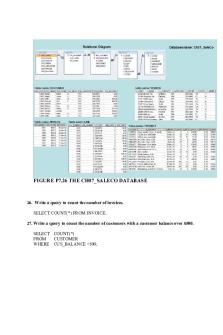
Ch7 - Ch7
- 11 Pages

Ch7 22 - Lecture notes 7
- 26 Pages
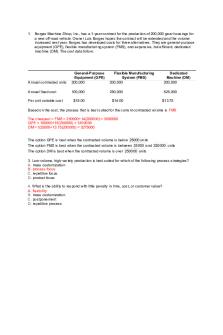
Ch7
- 4 Pages

Test bank ch 7 - pratical ch7
- 29 Pages

HTH 210 CH 7 - Lecture notes ch7
- 2 Pages
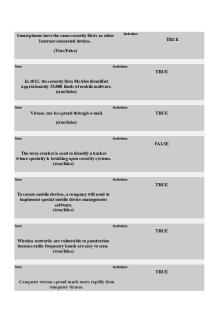
Testbank ch7
- 4 Pages
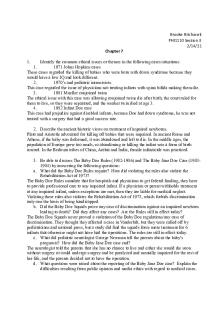
PHI1110 CH7
- 3 Pages

Chapter 7 quiz#7
- 3 Pages

Assignment #7 Chapter 7
- 2 Pages
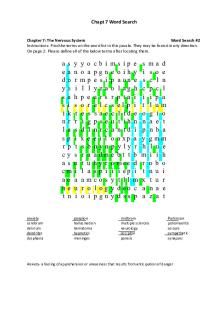
Ch7. Word Search
- 3 Pages

Ch7-practice Questions
- 5 Pages

CH7 review for final
- 2 Pages
Popular Institutions
- Tinajero National High School - Annex
- Politeknik Caltex Riau
- Yokohama City University
- SGT University
- University of Al-Qadisiyah
- Divine Word College of Vigan
- Techniek College Rotterdam
- Universidade de Santiago
- Universiti Teknologi MARA Cawangan Johor Kampus Pasir Gudang
- Poltekkes Kemenkes Yogyakarta
- Baguio City National High School
- Colegio san marcos
- preparatoria uno
- Centro de Bachillerato Tecnológico Industrial y de Servicios No. 107
- Dalian Maritime University
- Quang Trung Secondary School
- Colegio Tecnológico en Informática
- Corporación Regional de Educación Superior
- Grupo CEDVA
- Dar Al Uloom University
- Centro de Estudios Preuniversitarios de la Universidad Nacional de Ingeniería
- 上智大学
- Aakash International School, Nuna Majara
- San Felipe Neri Catholic School
- Kang Chiao International School - New Taipei City
- Misamis Occidental National High School
- Institución Educativa Escuela Normal Juan Ladrilleros
- Kolehiyo ng Pantukan
- Batanes State College
- Instituto Continental
- Sekolah Menengah Kejuruan Kesehatan Kaltara (Tarakan)
- Colegio de La Inmaculada Concepcion - Cebu

